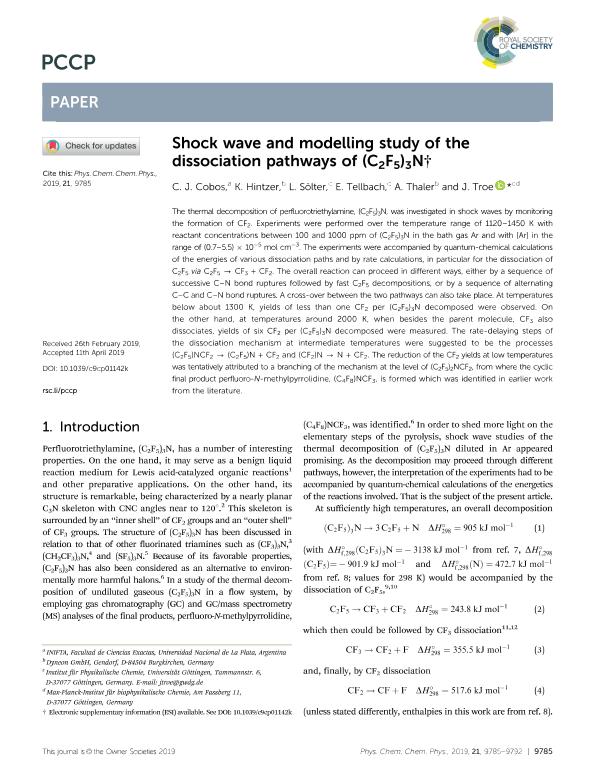Mostrar el registro sencillo del ítem
dc.contributor.author
Cobos, Carlos Jorge

dc.contributor.author
Hintzer, K.
dc.contributor.author
Sölter, L.
dc.contributor.author
Tellbach, E.
dc.contributor.author
Thaler, A.
dc.contributor.author
Troe, J.
dc.date.available
2020-11-24T18:20:11Z
dc.date.issued
2019-05
dc.identifier.citation
Cobos, Carlos Jorge; Hintzer, K.; Sölter, L.; Tellbach, E.; Thaler, A.; et al.; Shock wave and modelling study of the dissociation pathways of (C2F5)3N; Royal Society of Chemistry; Physical Chemistry Chemical Physics; 21; 19; 5-2019; 9785-9792
dc.identifier.issn
1463-9076
dc.identifier.uri
http://hdl.handle.net/11336/118914
dc.description.abstract
The thermal decomposition of perfluorotriethylamine, (C2F5)3N, was investigated in shock waves by monitoring the formation of CF2. Experiments were performed over the temperature range of 1120–1450 K with reactant concentrations between 100 and 1000 ppm of (C2F5)3N in the bath gas Ar and with [Ar] in the range of (0.7–5.5) × 10−5 mol cm−3. The experiments were accompanied by quantum-chemical calculations of the energies of various dissociation paths and by rate calculations, in particular for the dissociation of C2F5via C2F5 → CF3 + CF2. The overall reaction can proceed in different ways, either by a sequence of successive C–N bond ruptures followed by fast C2F5 decompositions, or by a sequence of alternating C–C and C–N bond ruptures. A cross-over between the two pathways can also take place. At temperatures below about 1300 K, yields of less than one CF2 per (C2F5)3N decomposed were observed. On the other hand, at temperatures around 2000 K, when besides the parent molecule, CF3 also dissociates, yields of six CF2 per (C2F5)3N decomposed were measured. The rate-delaying steps of the dissociation mechanism at intermediate temperatures were suggested to be the processes (C2F5)NCF2 → (C2F5)N + CF2 and (CF2)N → N + CF2. The reduction of the CF2 yields at low temperatures was tentatively attributed to a branching of the mechanism at the level of (C2F5)2NCF2, from where the cyclic final product perfluoro-N-methylpyrrolidine, (C4F8)NCF3, is formed which was identified in earlier work from the literature.
dc.format
application/pdf
dc.language.iso
eng
dc.publisher
Royal Society of Chemistry

dc.rights
info:eu-repo/semantics/openAccess
dc.rights.uri
https://creativecommons.org/licenses/by-nc/2.5/ar/
dc.subject
Shock wave
dc.subject
modelling study
dc.subject
dissociation pathways of (C2F5)3N
dc.subject.classification
Físico-Química, Ciencia de los Polímeros, Electroquímica

dc.subject.classification
Ciencias Químicas

dc.subject.classification
CIENCIAS NATURALES Y EXACTAS

dc.title
Shock wave and modelling study of the dissociation pathways of (C2F5)3N
dc.type
info:eu-repo/semantics/article
dc.type
info:ar-repo/semantics/artículo
dc.type
info:eu-repo/semantics/publishedVersion
dc.date.updated
2020-11-13T20:48:54Z
dc.journal.volume
21
dc.journal.number
19
dc.journal.pagination
9785-9792
dc.journal.pais
Reino Unido

dc.journal.ciudad
Cambridge
dc.description.fil
Fil: Cobos, Carlos Jorge. Consejo Nacional de Investigaciones Científicas y Técnicas. Centro Científico Tecnológico Conicet - La Plata. Instituto de Investigaciones Fisicoquímicas Teóricas y Aplicadas. Universidad Nacional de La Plata. Facultad de Ciencias Exactas. Instituto de Investigaciones Fisicoquímicas Teóricas y Aplicadas; Argentina
dc.description.fil
Fil: Hintzer, K.. Dyneon GmbH; Alemania
dc.description.fil
Fil: Sölter, L.. Universität Göttingen; Alemania
dc.description.fil
Fil: Tellbach, E.. Universität Göttingen; Alemania
dc.description.fil
Fil: Thaler, A.. Dyneon GmbH; Alemania
dc.description.fil
Fil: Troe, J.. Universität Göttingen; Alemania. Institut Max Planck fuer Bioanorganische Chemie; Alemania
dc.journal.title
Physical Chemistry Chemical Physics

dc.relation.alternativeid
info:eu-repo/semantics/altIdentifier/doi/https://doi.org/10.1039/C9CP01142K
dc.relation.alternativeid
info:eu-repo/semantics/altIdentifier/url/https://pubs.rsc.org/en/content/articlelanding/2019/cp/c9cp01142k#!divAbstract
Archivos asociados
